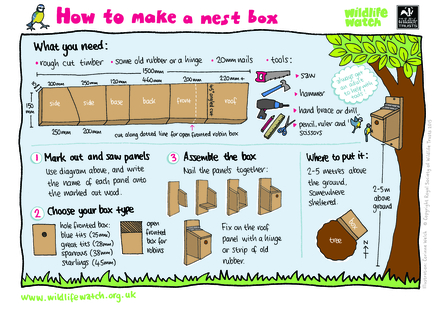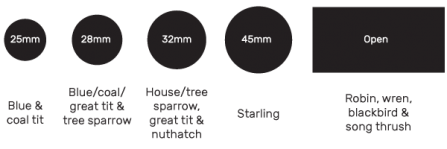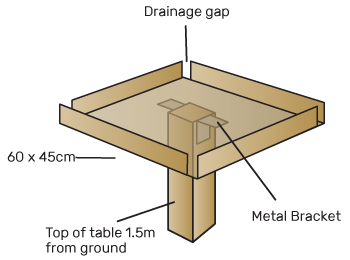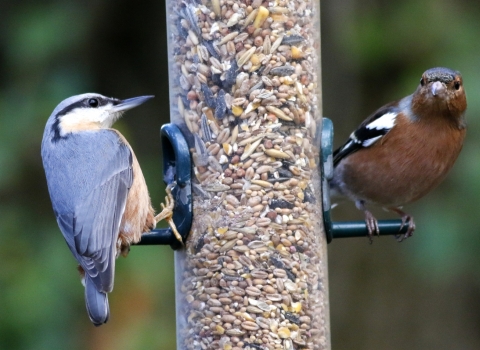Bird boxes
Birds are probably the most noticed visitors to our gardens, but some species such as house sparrows and house martins are becoming increasingly scarce due to habitat loss and disease. However, there are many simple actions you can take at home to help birds flourish on your patch.

Choosing the right box
Different types of box will attract different species. Whilst most birds prefer a closed box with a small entrance hole, some - like robins, wrens, blackbirds and song thrushes - use an open fronted box. Species like swifts, swallows and house martins require a specialist box as they nest under eaves and gable ends of buildings.

How to make a box in 8 steps
Build your own nest box
You will need: Rough cut, unplaned, untreated softwood timber, scrap rubber, galvanised nails, a saw, hammer, drill, pencil and ruler.
- Mark out panels with pencil and ruler to the dimensions shown above
- Cut the panels out.
- Decide on entrance hole size;
- Nail the side panels onto the back plate.
- Nail on the floor which fits inside the side panels.
- Nail the front panel onto side panels
- Drill drainage holes in the bottom
- Fix on the roof panel with a rubber or other hinge.
Optional:
Waterproof the box with an extra layer of damp proof membrane or roofing felt

Positioning your nest box
Place your box in a sheltered position on a tree or wall, facing north east to south east to avoid prevailing wet weather and the heat of the midday sun. Make sure your box is at least 2 meters off the ground and out of reach from predators.
Nest box hygiene and maintenance
Remove old nests in the autumn and wash with warm, soapy water to kill any remaining parasites, and let the box dry out thoroughly before closing the lid. If there are no drainage holes, now is the time to drill a few in the bottom.
Insecticides and flea powders must not be used. It is quite normal for a few eggs to fail to hatch, or for some young to die.
If you decorate your box, make sure you use a water-based paint and not lead-based paints or creosote, as these are toxic to birds. If you need to replace part of your bird box, avoid pressure treated wood, which contain harmful preservatives and fungicides.
Bird feeders
Feeding the birds
Putting up a feeder or table is one of the easiest way to attract birds to your garden, especially during the winter months when food is harder to come by. However, understanding food types and feeding habits will help you attract a variety of different species. It can take as long as a few months for birds to visit a new feeder.
Types of food and feeders
Use hanging feeders or a bird table. Diagram below on how to make your own.
Remember to clean both bird table and feeders regularly to avoid diseases spreading amongst your garden birds.
Different foods attract different bird so try a variety of foods such as wild bird seed mixes, niger seeds, peanuts and fatballs. It’s fun to make your own lard birdseed feeders.
Create a feature by using a post and basket brackets to hang your feeders on
If possible, site feeders close to a window for maximum enjoyment and if in a school, close to a class room window so children can observe from inside without disturbing the birds
Avoid hanging feeders within easy reach of predators such as cats by ensuring that they are not too low, or within reach of branches or fences.
Build your own bird table
You can construct a simple bird table from exterior grade plywood attached to a pole with metal brackets. A lip around the edge of the table will prevent food spilling over the edge, whilst gaps at the corners will provide drainage.

Live food and ground feeding
A number of garden birds are primarily ground feeders. These include blackbirds, song thrushes, collared doves, robins and dunnocks. Robins particularly love live mealworms, which are high in fat and protein. All of these birds are best fed from a bird table - find out how to make your own below.
Plants and insects
Chose a variety of pollinator and insect friendly plants for your garden to attract as many insect and other invertebrates as possible which is a natural and preferred food source for birds.
Choose plants and trees with berries and seeds for birds. For example trees like hawthorn, ivy, crabapple, rowan, holly and wild cherry and shrubs and plants like pyracantha, berberis and teasel.
What not to feed
Don’t put out salty food or dry bread as this can be harmful for birds. Also avoid cooking fats as these stick to bird's feathers and harbour bacteria. To avoid food poisoning, make sure to only provide live mealworm unless they are dried, and don't put out whole peanuts as these are a choking hazard.

